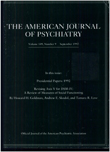Dissociation and childhood trauma in psychologically disturbed adolescents
Abstract
OBJECTIVE: To test the hypothesis that dissociation in adolescence is positively correlated with stress or abuse experienced earlier, the authors assessed dissociation in a heterogeneous group of disturbed adolescents and examined the relationship between the degree of dissociation and the degree of reported childhood stress, abuse, or trauma. METHOD: The subjects were 47 adolescents, 13-17 years old, who were institutionalized for periods of 1-13 weeks in a private mental hospital; 35 were girls and 12 were boys. Participants completed the Dissociative Experiences Scale and a child abuse and trauma questionnaire. The hospital records of 40 of the 47 adolescents were also available. RESULTS: Scores on the Dissociative Experiences Scale correlated significantly with self-reported physical abuse or punishment, sexual abuse, psychological abuse, neglect, and negative home atmosphere but not with abuse ratings made from hospital records. CONCLUSIONS: Together with the authors' previous work showing a relation between childhood stress and later dissociation in normal college students, these findings support the view that dissociation represents a reaction to early negative experience and places multiple personality disorder at the extreme end of a continuum of dissociative sequelae of childhood trauma. Researchers should continue to try to identify psychiatric patients with prominent dissociative characteristics or symptoms and attempt to correlate this phenomenology with negative earlier experiences.
Access content
To read the fulltext, please use one of the options below to sign in or purchase access.- Personal login
- Institutional Login
- Sign in via OpenAthens
- Register for access
-
Please login/register if you wish to pair your device and check access availability.
Not a subscriber?
PsychiatryOnline subscription options offer access to the DSM-5 library, books, journals, CME, and patient resources. This all-in-one virtual library provides psychiatrists and mental health professionals with key resources for diagnosis, treatment, research, and professional development.
Need more help? PsychiatryOnline Customer Service may be reached by emailing [email protected] or by calling 800-368-5777 (in the U.S.) or 703-907-7322 (outside the U.S.).



